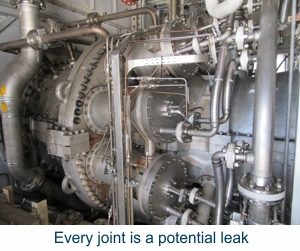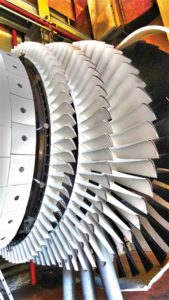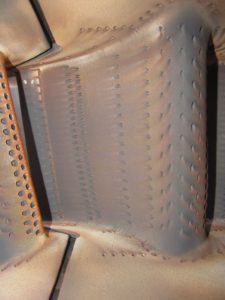Safely Check for Gas Turbine Fuel/Air Leaks
 Traditionally operations and maintenance personnel have used gas detectors to check the fuel pig tail flanges for leaks during the startup process. This is to ensure that no fuel is present that could cause a fire in the compartment. An less risky alternative to this process is to perform a soapy water check while the unit is on crank. A pressurized garden sprayer is filled with soapy water and while the unit is being cranked and sufficient air pressure is present the entire unit is sprayed down with the soapy water mixture. Not only will this produce evidence of leakage at the fuel flanges but will reveal any air leaks on the can bases, the wrapper four way joints, the primary fuel covers or anywhere else air can escape.
Traditionally operations and maintenance personnel have used gas detectors to check the fuel pig tail flanges for leaks during the startup process. This is to ensure that no fuel is present that could cause a fire in the compartment. An less risky alternative to this process is to perform a soapy water check while the unit is on crank. A pressurized garden sprayer is filled with soapy water and while the unit is being cranked and sufficient air pressure is present the entire unit is sprayed down with the soapy water mixture. Not only will this produce evidence of leakage at the fuel flanges but will reveal any air leaks on the can bases, the wrapper four way joints, the primary fuel covers or anywhere else air can escape.
Since this a relatively simple and safe procedure TGM® recommends performing this check prior to any maintenance being performed (after the unit is shut down and just before the LOTO is initiated). Any and all air leaks can be identified and they can be addressed during the scheduled maintenance cycle if feasible.
There have been several TIL’s released on the care and quality of the flexible metal hoses for CT’s. The end user has gotten into the practice of having the flexible metal hose pressure checked during the hot gas path cycle. If the soapy water checks are performed prior to any work being performed and any of the flexible metal hoses are leaking then why bother to have them pressure checked. This approach can save expensive labor cost by eliminating a test on a hose that will fall out. Plus wouldn’t it be better to know you have a leak at the wrapper four way joint before it is removed to perform a hot gas path than finding out during the inspection at start up?

 Thermal Barrier Coatings (TBCs) protect the first several rows of hot gas path parts from the high combustion temperatures in many advanced large frame turbines. Not all coating applications are equal, and some can even reduce the efficiency of your unit.
Thermal Barrier Coatings (TBCs) protect the first several rows of hot gas path parts from the high combustion temperatures in many advanced large frame turbines. Not all coating applications are equal, and some can even reduce the efficiency of your unit. If a combustion turbine experiences reduced power output and heat rate, the usual suspect is compressor fouling. But what if cleaning the compressor through on-line and off-line wash is not enough to recover lost compressor efficiency?
If a combustion turbine experiences reduced power output and heat rate, the usual suspect is compressor fouling. But what if cleaning the compressor through on-line and off-line wash is not enough to recover lost compressor efficiency?